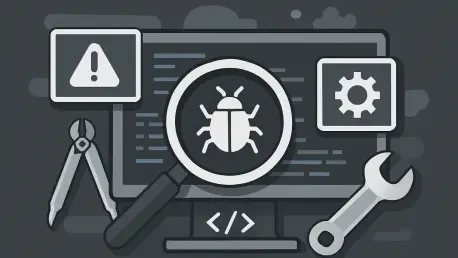What happens when a production system crashes without warning, bleeding thousands of dollars per minute, and the only person available to fix it has never seen the codebase before? This high-pressure nightmare is a stark reality for many developers in 2025, where sprawling, interconnected systems often outpace documentation and team familiarity. Zero-context debugging—troubleshooting complex issues with no prior knowledge—has become a critical skill in an era of rapid software evolution. This article dives into the challenges and solutions surrounding this daunting task, offering a lifeline for those thrust into the deep end of enterprise environments.
The Urgency of Unfamiliar Codebases
In today’s tech landscape, the stakes couldn’t be higher when systems fail. With businesses relying on intricate microservices and hybrid cloud setups, a single glitch can cascade into catastrophic downtime. Developers are increasingly tasked with resolving critical bugs in unfamiliar terrain, often under intense time constraints. The financial impact is staggering—studies estimate that system outages cost enterprises an average of $300,000 per hour, amplifying the need for swift, effective debugging skills.
The rise of remote work and high turnover in tech teams has only compounded this issue. Siloed knowledge and outdated documentation mean that stepping into an unknown system is no longer a rare occurrence but a frequent hurdle. Zero-context debugging isn’t just a technical challenge; it’s a business imperative that can make or break operational stability in a hyper-competitive market.
Core Strategies for Navigating the Unknown
Success in zero-context scenarios hinges on a few foundational pillars that can transform chaos into clarity. First, documentation serves as a critical starting point, even if incomplete or AI-generated. Clear guides on architecture and operations can shave hours off the initial learning curve, providing a roadmap through uncharted code. Without this, developers risk floundering in guesswork, wasting precious time.
Automation stands as another essential ally, streamlining setup and builds to bypass configuration headaches. Tools like Dockerized environments or CI/CD pipelines ensure consistency, allowing focus to remain on problem-solving rather than environment mismatches. Observability tools, such as dashboards and tracing systems, act as eyes into the system’s behavior, revealing anomalies in production failures. Finally, robust test suites offer a safety net, helping to understand logic flows while guarding against unintended side effects of fixes. Each of these elements plays a distinct role in taming the uncertainty of unfamiliar systems.
Expert Perspectives on High-Stakes Debugging
Insights from seasoned professionals underscore the real-world impact of these strategies. A veteran software engineer shared, “During a critical outage, observability dashboards were a game-changer—within minutes, key metrics pointed to a bottleneck that logs alone couldn’t reveal.” Such tools are often the difference between hours of blind searching and targeted resolution.
Another compelling story comes from a development team that tackled a severe memory leak in production. By leveraging an automated toolchain, they replicated the environment and isolated the issue in record time, averting further loss. Research backs these anecdotes, showing that teams with comprehensive documentation resolve issues 30% faster on average. These accounts and data highlight the tangible benefits of preparation and structured approaches in the heat of a crisis.
A Practical Roadmap for Zero-Context Challenges
For those facing an unfamiliar system under pressure, a step-by-step framework can provide much-needed direction. Begin by scouring any available logs or documentation to establish a baseline, no matter how fragmented the information might be. Next, utilize automated setups to replicate the environment quickly, ensuring no time is lost on manual configurations. Observability tools should then be employed to monitor metrics and trace requests, pinpointing where anomalies arise.
Iterative testing comes into play to validate current behavior and protect against new errors during fixes. Safe experimentation, supported by change management for controlled rollbacks, allows for cautious progress. For deeper issues, specialized tools like heap dumps can uncover hidden culprits, while realistic test data—sanitized from production or synthetically crafted—mirrors actual conditions. Simulating dependencies with mock implementations, adhering to compliance via CI/CD policies, and tapping AI for code summaries or log analysis round out this comprehensive approach. Each step builds toward resolution with precision and efficiency.
Overcoming Barriers with Systematic Preparation
The challenges of zero-context debugging often stem from systemic gaps, such as poor documentation or lack of standardized processes. Addressing these requires a cultural shift within organizations to prioritize onboarding resources and automated workflows. When teams invest in clear guides and paved paths for debugging tools, they equip developers to handle crises without starting from scratch.
Moreover, fostering a mindset of continuous improvement ensures that lessons from past incidents feed into better practices. Encouraging the use of AI as a supportive tool—not a crutch—can accelerate comprehension without sacrificing critical thinking. By embedding these principles, companies can reduce the friction of unfamiliar systems, turning a daunting task into a manageable process. The evidence is clear: preparation is not a luxury but a necessity in modern software development.
Looking back, the journey through zero-context debugging revealed a landscape where preparation and structure triumphed over chaos. Reflecting on the high-stakes scenarios and expert insights, it became evident that success hinged on actionable frameworks and robust tools. Moving forward, developers and organizations alike should commit to building comprehensive documentation, embracing automation, and leveraging observability to preempt future crises. Investing in these areas now will pave the way for resilience, ensuring that even the most unfamiliar codebases no longer pose an insurmountable threat. The path ahead lies in proactive steps—equipping teams with the right resources to debug with confidence, no matter the context.









